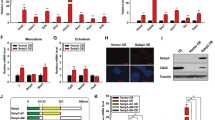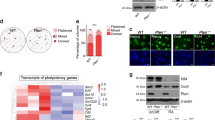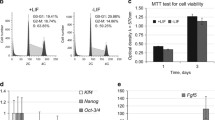Abstract
Previous studies have demonstrated that transcription factor Etv5 plays an important role in the segregation between epiblast and primitive endoderm at the second fate decision of early embryo. However, it remains elusive whether Etv5 functions in the segregation between inner cell mass and trophectoderm at the first cell fate decision. In this study, we firstly generated Etv5 knockout mouse embryonic stem cells (mESCs) by CRISPR/Cas9, then converted them into extended potential stem cells (EPSCs) by culturing the cells in small molecule cocktail medium LCDM (LIF, CHIR99021, (S)-(+)-dimethindene maleate, minocycline hydrochloride), and finally investigated their differentiation efficiency of trophoblast stem cells (TSCs). The results showed that Etv5 knockout significantly decreased the efficiency of TSCs (CDX2+) differentiated from EPSCs. In addition, Etv5 knockout resulted in higher incidence of the differentiated cells with tetraploid and octoploid than that from wild type. Mechanistically, Etv5 was activated by extracellular-signal-regulated kinase (ERK) signaling pathway; in turn, Etv5 had a positive feedback on the expression of fibroblast growth factor receptor 2 (FGFR2) which lies upstream of ERK. Etv5 knockout decreased the expression of FGFR2, whose binding with fibroblast growth factor 4 was essentially needed for TSCs differentiation. Collectively, the findings in this study suggest that Etv5 is required to safeguard the TSCs differentiation by regulating FGFR2 and provide new clues to understand the specification of trophectoderm in vivo.





Similar content being viewed by others
References
Sharrocks AD (2001) The ETS-domain transcription factor family. Nat Rev Mol Cell Biol 2(11):827–837. doi:https://doi.org/10.1038/35099076
Findlay VJ, LaRue AC, Turner DP, Watson PM, Watson DK (2013) Understanding the role of ETS-mediated gene regulation in complex biological processes. Adv Cancer Res 119:1–61. doi:https://doi.org/10.1016/B978-0-12-407190-2.00001-0
Zhou Q, Chipperfield H, Melton DA, Wong WH (2007) A gene regulatory network in mouse embryonic stem cells. Proc Natl Acad Sci U S A 104(42):16438–16443. doi:https://doi.org/10.1073/pnas.0701014104
Zhang J, Cao H, Xie J, Fan C, Xie Y, He X, Liao M, Zhang S, Wang H (2018) The oncogene Etv5 promotes MET in somatic reprogramming and orchestrates epiblast/primitive endoderm specification during mESCs differentiation. Cell Death Dis 9(2):224. https://doi.org/10.1038/s41419-018-0335-1
Lujan E, Zunder ER, Ng YH, Goronzy IN, Nolan GP, Wernig M (2015) Early reprogramming regulators identified by prospective isolation and mass cytometry. Nature 521(7552):352–356. doi:https://doi.org/10.1038/nature14274
Kang M, Garg V, Hadjantonakis AK (2017) Lineage establishment and progression within the inner cell mass of the mouse blastocyst requires FGFR1 and FGFR2. Dev Cell 41(5):496-510 e495. https://doi.org/10.1016/j.devcel.2017.05.003
Ornitz DM, Itoh N (2015) The fibroblast growth factor signaling pathway. Wiley Interdiscip Rev Dev Biol 4(3):215–266. https://doi.org/10.1002/wdev.176
Molotkov A, Mazot P, Brewer JR, Cinalli RM, Soriano P (2017) Distinct requirements for FGFR1 and FGFR2 in primitive endoderm development and exit from pluripotency. Dev Cell 41(5):511-526 e514. https://doi.org/10.1016/j.devcel.2017.05.004
Kunath T, Yamanaka Y, Detmar J, MacPhee D, Caniggia I, Rossant J, Jurisicova A (2014) Developmental differences in the expression of FGF receptors between human and mouse embryos. Placenta 35(12):1079–1088. doi:https://doi.org/10.1016/j.placenta.2014.09.008
Kurowski A, Molotkov A, Soriano P (2019) FGFR1 regulates trophectoderm development and facilitates blastocyst implantation. Dev Biol 446(1):94–101. doi:https://doi.org/10.1016/j.ydbio.2018.12.008
Yang Y, Liu B, Xu J, Wang J, Wu J, Shi C, Xu Y, Dong J, Wang C, Lai W, Zhu J, Xiong L, Zhu D, Li X, Yang W, Yamauchi T, Sugawara A, Li Z, Sun F, Li C, He A, Du Y, Wang T, Zhao C, Li H, Chi X, Zhang H, Liu Y, Duo S, Yin M, Shen H, Belmonte JC, Deng H (2017) Derivation of pluripotent stem cells with in vivo embryonic and extraembryonic potency. Cell 169(2):243–257. https://doi.org/10.1016/j.cell.2017.02.005
Kubaczka C, Schorle H (2016) Protocol for the direct conversion of murine embryonic fibroblasts into trophoblast stem cells. J Vis Exp 113:54277. https://doi.org/10.3791/54277
Zhang SQ, Xie YL, Cao HX, Wang HY (2017) Common microRNA-mRNA interactions exist among distinct porcine iPSC lines independent of their metastable pluripotent states. Cell Death Dis 8:E3027
Ying Q-L, Wray J, Nichols J, Batlle-Morera L, Doble B, Woodgett J, Cohen P, Smith A (2008) The ground state of embryonic stem cell self-renewal. Nature 453(7194):519–523
Sohni A, Bartoccetti M, Khoueiry R, Spans L, Vande Velde J, De Troyer L, Pulakanti K, Claessens F, Rao S, Koh KP (2015) Dynamic switching of active promoter and enhancer domains regulates Tet1 and Tet2 expression during cell state transitions between pluripotency and differentiation. Mol Cell Biol 35(6):1026–1042. doi:https://doi.org/10.1128/MCB.01172-14
Kalkan T, Bornelov S, Mulas C, Diamanti E, Lohoff T, Ralser M, Middelkamp S, Lombard P, Nichols J, Smith A (2019) Complementary activity of ETV5, RBPJ, and TCF3 drives formative transition from naive pluripotency. Cell Stem Cell. https://doi.org/10.1016/j.stem.2019.03.017
Yang J, Ryan DJ, Lan G, Zou X, Liu P (2019) In vitro establishment of expanded-potential stem cells from mouse pre-implantation embryos or embryonic stem cells. Nature Protocols 14(2):350–378. https://doi.org/10.1038/s41596-018-0096-4
Tanaka S, Kunath T, Hadjantonakis AK, Nagy A, Rossant J (1998) Promotion of trophoblast stem cell proliferation by FGF4. Science 282(5396):2072–2075. doi:https://doi.org/10.1126/science.282.5396.2072
Niwa H, Toyooka T, Shimosato D, Strumpf D, Takahashi K, Yagi R, Rossant J (2005) Interaction between Oct3/4 and Cdx2 determines trophectoderm differentiation. Cell 123(5):917–929. doi:https://doi.org/10.1016/j.cell.2005.08.040
Turner N, Grose R (2010) Fibroblast growth factor signalling: from development to cancer. Nat Rev Cancer 10(2):116–129. doi:https://doi.org/10.1038/nrc2780
Lu CW, Yabuuchi A, Chen LY, Viswanathan S, Kim K, Daley GQ (2008) Ras-MAPK signaling promotes trophectoderm formation from embryonic stem cells and mouse embryos. Nat Genet 40(7):921–926. doi:https://doi.org/10.1038/ng.173
Jamsai D, Clark BJ, Smith SJ, Whittle B, Goodnow CC, Ormandy CJ, O’Bryan MK (2013) A missense mutation in the transcription factor ETV5 leads to sterility, increased embryonic and perinatal death, postnatal growth restriction, renal asymmetry and polydactyly in the mouse. PLoS One 8(10):e77311. https://doi.org/10.1371/journal.pone.0077311
Xu X, Weinstein M, Li C, Naski M, Cohen RI, Ornitz DM, Leder P, Deng C (1998) Fibroblast growth factor receptor 2 (FGFR2)-mediated reciprocal regulation loop between FGF8 and FGF10 is essential for limb induction. Development 125(4):753–765
Acknowledgements
We thank Dr. Jinglong Zhang for helping on generation of Etv5 KO mESCs, Xiaomin Du for helping on bisulfite sequencing experiment, Juqing Zhang and Zhenshuo Zhu for helping on vector construction in this work. This research was supported by grants from State Key Laboratory of Genetically Engineered Veterinary Vaccines (AGVSKL-ZY-201802, AGVSKL-ZD-202009), NWAFU Fundamental Research Funds for the Central Universities (2452019055), and National Natural Science Foundation of China (31571521, 31301218).
Author information
Authors and Affiliations
Corresponding authors
Ethics declarations
Conflict of inerest
The authors declare that they have no conflict interest.
Ethical approval
This article does not contain any studies with human participants or animals performed by any of the authors.
Additional information
Publisher's Note
Springer Nature remains neutral with regard to jurisdictional claims in published maps and institutional affiliations.
Electronic supplementary material
Below is the link to the electronic supplementary material.
Rights and permissions
About this article
Cite this article
Zhu, K., Liu, Y., Fan, C. et al. Etv5 safeguards trophoblast stem cells differentiation from mouse EPSCs by regulating fibroblast growth factor receptor 2. Mol Biol Rep 47, 9259–9269 (2020). https://doi.org/10.1007/s11033-020-05969-4
Received:
Revised:
Accepted:
Published:
Issue Date:
DOI: https://doi.org/10.1007/s11033-020-05969-4




